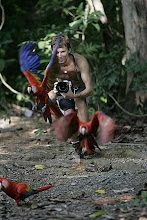Taking digital photos through binoculars can be rather difficult, particularly if the light is poor. The two hardest things about digibinning the snowfinches was that the light was low (because of the heavy snow and fog), and blown out (lots of matt, bright white and dark areas too dark for detail). These are tough lighting conditions even for the best dSLR cameras, let alone a small point-and-shoot like the Canon A590IS I use for digibinning and digiscoping. With a little bit of patience, I found that I could get some okay shots through my binoculars (well, they are swarovski EL's after all ;-)
The trick to taking photos through binoculars is to:
- get good light
- get close enough to not have to use the camera's zoom (a real image-killer as the lenses on the small point and shoot digital cameras are rather poor, in general)
- get good light
- hold the binoculars vertical in your left hand, having access to the focus knob with your left hand's fingers, and freeing up your right hand to handle the camera
- use a good pair of binoculars - high quality lenses are likely to give you much more light (faster shutter speeds = sharper images) and a better quality of image.
- if you are lucky, your camera's lens will fit snuggly in to the eye-cup of your binoculars. If this is not the case, you will either need to use something like the swarovski snapshot adaptor, or try your luck with holding the camera lens at the right angle and in the right position (no easy feat, but I have done it for some decent video and photos of leopards and black rhino as well as an African Fish Eagle - beautiful!)
- With the binoculars rested on your lower hand, lower fingers focussing, and right hand free to operate the camera, you are all set to find subjects.
- Backlight is a real photo-killer for digibinning, so you will want to position yourself with the light shining on the subject.
If you look at the three snowfinch images above, you will immediately notice a few things:
- Vignetting can be an issue. This can be avoided by zooming the camer a little bit, but this has two major side effects: 1. you put more strain on the camera lens which tends to produce softer/blurred images, and 2. you reduce the maximum possible shutter speed
- Because the lighting was harsh, the image resutls tend to have blown out whites, and feature-less darks. this can be corrected to some extent by post-processing (see the first snowfinch image with the one snowfinch flying towards the feeder). In this image I reduced the intensity of the highlights and brightened the darks. The result is that one can now see more details, but - unfortunately - the image looks photoshopped and artificial.
- Even under tough conditions, digibinning can help you get a few photos to take home with you! (even if they are not always national geographic-ready)
Dale

No comments:
Post a Comment